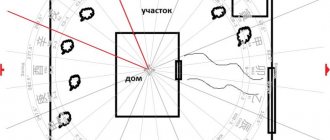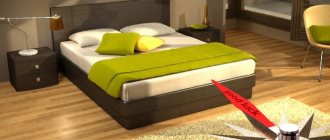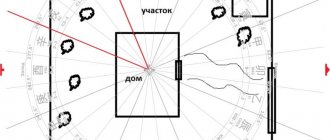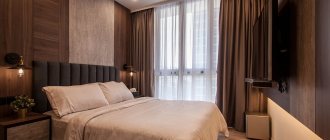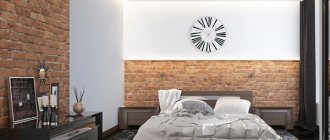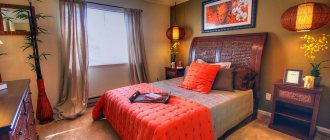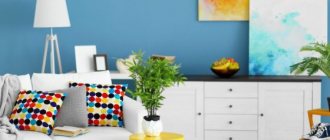Fence height
Ideally, according to Feng Shui, the fence should be no higher than 1.8 meters and maintain the same height along the entire perimeter of the plot, especially in the place where the fence is adjacent to the gate. According to Feng Shui, a hedge that slopes sharply down near a gate symbolizes the river bed. In this place, a flow of positive energy flows away from the territory of the site, and along with this flow, well-being and harmony leave the family.
Ngo Minh Tuan/Pixabay
The gentle slopes of high gates are also unfavorable: positive energy, trying to penetrate inside, breaks against the gate and flows down the sides. This can lead to cooling of feelings between spouses. If the same height cannot be maintained along the entire length of the fence, make sure that it is even in height at least on straight sections. An uneven fence dissipates positive chi energy.
Gates and gates, like the door to a house, should open inward. If they swing outward, they prevent chi from entering the area, as if pushing it away.
What trees to plant along the fence
Trees for planting on the outside of the fence
Trees on the outside of the street, in addition to their aesthetic function, act as a kind of filter that traps street dust and exhaust gases. For the outside of the fence, trees that can withstand pruning well and are not too valuable or rare are suitable, this will help avoid vandalism. In addition, you need to choose plants that are unpretentious and resistant to frost, drought and other unfavorable conditions. The following are most suitable for these purposes:
- small-leaved elm
- common elm
- Rowan
- river maple
- Tatarian maple
Common elm
In the wild, the common elm is distributed almost everywhere in deciduous forests. It is found in the European part, in Siberia, the Caucasus, and the Baltic states. In Kazakhstan. The tree grows up to 25 meters in height. The plant is shade-tolerant and drought-resistant.
Elm has been used in landscaping for a very long time, due to the fact that it not only tolerates shearing well, but also holds its given shape well. Has many decorative forms:
- silver-motley
- golden-variegated
- red
The disadvantages of elm plantings include their demands on soil fertility. On poor soils, the growth of these trees slows down. In addition, elms can attract unwanted pests and be actively damaged by them. An undoubted advantage is that the common elm lives for a very long time, up to 200-300 years.
Conifers for the inside of the fence
On the inside of the fence, you can plant primarily coniferous trees with slow growth and with decorative needles and crown. In addition to being decorative, coniferous trees purify the air and emit phytoncides that are beneficial to health. In the summer, bright annual flowers can be planted near the plantings to create a contrast with the dark needles.
Suitable for planting near the fence on the inside:
- low-growing species of prickly spruce
- medium-sized species of common spruce
- decorative types of spruce
Norway spruce Acrocona
This species grows no more than 8 cm per year, an adult plant is no more than 3.0 m in height. The crown is conical, with a wide base up to 4.0 m. needles of rich green color. Young pink cones make the trees elegant and attractive. This species does not tolerate dry soils with high salinity.
In addition to spruce trees, low-growing thujas and pines can be grown along the fence. larches. Despite the variety of species and varieties of coniferous and deciduous trees, most property owners when decorating fences give preference to unpretentious shrubs.
Feng Shui fence material
According to Feng Shui, it is preferable to use natural materials in any construction. Below is a table according to which you can choose a fence material, focusing on the cardinal points. The direction is determined based on the center of the site.
| Direction | Element | Material |
| north | Water | metal |
| northeast | Earth | stone, brick, metal, reinforced concrete |
| East | Tree | tree |
| southeast | Tree | tree |
| south | Fire | stone, brick, reinforced concrete |
| southwest | Earth | stone, brick, metal, reinforced concrete |
| west | Metal | stone, brick, metal |
| northwest | Metal | metal, stone, brick |
Shrubs
You can hide an unsightly fence with the help of bushes. Decorative varieties include lilac. It is unpretentious in care, able to please with beautiful flowering and a pleasant aroma.
Tumberg barberry will help decorate the fence. The shrub grows up to 90 cm and is shaped like a ball. In autumn, the leaves turn red with a yellow edge. Barberry does not need additional watering; it gets enough rain, but it is demanding on lighting. In addition, the plant does not like cold, so it is better to plant it on the south side of the site.
Spiraea is popular among summer residents. This is an unpretentious shrub. It attracts with its abundant flowering and high growth rate. The bush must be pruned in a timely manner so that the plant does not acquire an unkempt appearance. Today there are many varieties of spirea. They differ in the color of leaves and flowers. Read more in the article.
A favorite among dacha owners is derain. It grows quickly and the castings are painted silver with white edges. If you plant several bushes in the spring, then by autumn you can get a finished hedge up to 1 meter high. It is necessary to take into account that derain requires a lot of space, so combining it with other shrubs will not work.
Latest posts Ingenious tricks for growing tomato seedlings from experienced gardeners 6 ideas on how to use cut branches in the country and at home What to put in the ground when planting cucumbers for seedlings so that powerful vines will form by the summer season
Along the fence you can plant fruit bushes such as raspberries, currants, blackberries, and honeysuckle. While currants are fairly easy to care for, raspberries and blackberries can present certain difficulties. When planting blackberries, you must ensure that their branches do not touch the ground, otherwise they will sprout. Raspberries constantly have shoots on their roots. If it is not removed in time, then neat bushes will turn into impenetrable thickets.
Honeysuckle is very unpretentious and easy to care for. It has oblong blue berries that taste good. These are the earliest berries that you can try in the country. Honeysuckle branches heavily, so the branches should be trimmed periodically. But thanks to this quality, it can be made into an excellent hedge. The main thing is to give it shape using scissors.
Chokeberry is also well suited for planting in the country along the fence. In spring, delicate pinkish inflorescences look beautiful against the background of dark green leaves. In summer, rowan will delight you with a bountiful harvest of black, sweet-tart berries. In autumn, the plant will attract the eye with bright red foliage.
How to choose a color for your home?
When choosing a paint color for your home, it is important to consider several rules that experienced designers use:
- The building should fit harmoniously into the general style of neighboring houses, not be too gray in comparison with them, and not look vulgar. If you want to highlight your home a little, you can use brighter colors.
- It is important to consider the style of the building. So, castle requires the color of natural stone or warm tones of red paint. Rustic is ideal in natural colors - honey, brown, pastel.
- The tone of the entire suburban area is set by the color of the roof - you should not use too dark colors. The color of the facade, windows, front door, stairs, drainpipes, fence, benches, and gazebos depends on the roof.
- For a house located in the sun, it is better to choose matte paints. Shiny glossy ones are suitable for shaded areas.
Color combination of fence and house
A classic scheme for coloring your own home might look like this:
- Light top with dark bottom. The doors and windows are painted in the color of the light roof. The fence should also be light, because it is known that the fence and the roof should be made in the same color.
- Dark top with light bottom. Traditional, most common and easy to understand combination.
- Tone on tone. The building looks like a single whole, but slightly smacks of facelessness.
The range of colors used for roofing looks like this: red, brown, terracotta, gray, blue. Fences should also be painted in these colors. The color of red tiles and bricks requires the same color of the fence, although its saturation may be greater. Initially, the color of the house should be determined by the presence of greenery on the site - trees, bushes, lawns. If the trees are small and there is not much greenery, natural colors and their shades will be the optimal solution.
Family
The zone is designed to strengthen family relationships and family ties. This place should become a gathering place for the whole family; a family recreation area and a summer living room, intended for evening tea or a home-cooked meal, are often set up here.
You can also place a pond or swimming pool here, and a hedge will perfectly play the role of a fence from curious neighbors.
The most popular colors of fences for private houses and summer cottages
Photo No. 3: brown fence
⦁ BROWN. Perhaps the undisputed bestseller. The color, however, is not so monotonous. In the above-mentioned RAL table we find at least 20 shades of brown: from light beige to chocolate.
Brown fences harmonize perfectly with houses made of white brick, and with wooden log houses, and with cottages made of timber. The shades in this range are not flashy, but quite rich. Here is the answer to the question why brown is so popular.
½ IMPORTANT! Experts advise matching the tone of the fence to the color of the roof of the house. After all, it is the roof that rises above the upper edge of the fence and, together with the fence, forms the picture of the first impression of a private property (estate).
Photo No. 4: green fence
⦁ GREEN. A very popular color for fences in summer cottages. From the point of view of landscape design, a fence in green tones will ideally outline an area with a large number of shrubs and trees, as if continuing the theme of bright foliage. In winter, when there is no natural greenery, a green perimeter will prevent the site from looking completely boring and gray.
Photo No. 5: red, burgundy, cherry fence
⦁ RED, BURGUNDY, CHERRY. Essentially, the shades continue the brown theme, but look richer and brighter. Such fences are good around mansions using light yellow facing bricks; the cherry “frame” looks especially stylish near plastered light gray or pale pink walls.
INTERESTING! Do not forget that modern technologies make it possible to achieve two color coating options: matte or glossy.
A glossy surface is easier to clean from dust, but it is very shiny in the sun and can become excessively hot when it comes to dark colors.
The matte coating has a rough structure, creating a “warm”, cozy, seemingly soft surface (only externally). This coating looks richer and costs more.
Photo No. 6: blue fence against the background of the house
⦁ BLUE. Recently, color has entered the palette of especially popular tones. Dark blue and even light blue fences do not stand out much in the general row of green or brownish-red fences, but at the same time they look non-standard.
UNUSUAL! Nowadays it is not difficult to think over and implement a non-standard color scheme for a fence. Let your imagination run wild with the designer. What do you say, for example, about such combinations:
- pink roof - gray fence;
- green - beige;
- dark brown - blue-gray?
Photo No. 7: tree-like fence
Photo No. 8: stone fence
⦁ “UNDER THE TREE” and “UNDER THE STONE”. Manufacturers have learned how to decorate corrugated sheets in this way. We are, of course, not talking about a paint coating, but a polymer one. A thin layer of textured material in liquid form is fused onto the galvanized surface of the rolled metal. When the polymer hardens, the fence material is ready to imitate rocky, woody textures. It looks quite natural and not tasteless.
Photo No. 9: combined - green fence with red gate
⦁ COMBINED. It may be appropriate to paint the gate one color and the remaining sections of the fence another. Properly combined shades and materials ultimately look stylish. The color accent on the entrance group (gate) is quite understandable.
It remains to remind you that all the painting options mentioned in the article are best applicable to corrugated fences. You can order the production and installation of fencing made of metal, brick or wood at. We work inexpensively, but with high quality, adding a sense of comfort and tranquility to every project carried out by our team.
Before you decide on what colors of corrugated fences are optimal, you need to remember what a profiled sheet is. This modern and popular building material is made from cold-rolled sheet steel by processing on rollers of a certain shape. This treatment significantly improves the mechanical properties of sheet metal, including its strength and load-bearing capacity.
Any modern corrugated sheet has reliable anti-corrosion protection. This can be not only galvanic coating of zinc or aluzinc, but also additional painting with special polymer-based compounds.
Corrugated sheeting for a red fence (photo of the fence of a summer cottage
This coloring, in addition to the zinc protective layer, not only increases the resistance of the profiled sheet against corrosion and other external factors, but also makes the corrugated sheet look aesthetically attractive. It is the colored corrugated sheeting for the fence that is considered the ideal material for the construction of fences for personal and summer cottages.
Zone distribution
In order to divide the area into zones, you need to stand near the entrance and mentally divide the entire territory into three equal horizontal stripes. Then the same stripes are drawn vertically.
This can be done much more clearly on a site plan. To do this, a schematic plan of the territory is drawn on paper, which is divided into nine equal squares.
This distribution is ideal for a square plot. For a territory characterized by uneven shapes, first of all it will be necessary to deal with those sectors that contain the least amount of land.
The first strip is designed to provide (from right to left) Wisdom (or Knowledge), Career, Friends (or Good Helpers).
The second line is responsible for Family, Health (or Vitality), Children.
The far section will attract Wealth, Fame, Partnership.
Creating a unique winter garden design
It’s not difficult to design a garden plot on your own. To do this, you need to know in advance which plants will look beautiful in winter and winter garden design will not be a problem for you.
Unusually beautiful bright colors of summer, golden shades of autumn and charming greenery of spring.
All these colors of nature are replete with their exceptional beauty; only winter, which lasts six months in our country, is slightly inferior to them.
Winter frosts, piercing winds, blizzards and blizzards do their job, and nature falls asleep.
But this also has its own unique charm. Trees shrouded in snow are no less picturesque than in summer. And we must not forget to appreciate what nature has given us, because she does everything for a reason.
Some people believe that winter is a hibernation not only for plants, but also for creativity. This is a misconception.
If you put in some effort, you can create your own garden that will bloom and delight you all year round. And create your own winter fairy tale without much effort.
The main thing is a properly planned area and the right selection of trees and shrubs.
First you need to find plants that stand out from the rest in both summer and winter. You also need to properly and thoroughly prepare your garden for winter.
To begin with, you should choose winter-hardy plants. First, you need to select deciduous trees that have an unusual crown, for example: weeping willow, birch, larch, and so on.
Secondly, these are coniferous plants, since against the background of snow-white cover these plants will look especially beautiful. They are able to amaze anyone with their variety of shades. Just like spruce, which has a blue-blue color, so do juniper or pine, which is dark green and has varying shades of green.
Rowan, viburnum, sea buckthorn, rose hips and decorative apple trees will look very beautiful. Thorny bushes also look extraordinary if they are planted as a dense hedge or in groups.
It is in winter that the unique silhouette of the crown, the shade of barberry and hawthorn bark are clearly visible. And ground cover plants - Erica, cloves, heather, thyme, periwinkle - will weave a magnificent carpet.
Autumn and winter in the garden are the high point for grains. Also, do not rush to prune perennial flowers.
Only those that freeze and lose their shape (peonies) are pruned. And perennials - mullein, wormwood, yarrow, hare cabbage perfectly retain their shape in winter, and in snow and frost they will look charming.
In winter you also have many opportunities to create your own extraordinary garden design. After all, winter paints its own extraordinary picture every time it envelops your garden with its blanket of snow. You just need to try to see them.
Rules for choosing colors
- The harmony of a single ensemble of any estate is achieved by a reasonable combination of the color of the roof, walls and fence. Whatever color they are, the roof should be darker than the walls, and the fence should be the same tone as the roof.
- All buildings and fences can be made multi-colored, but experts do not recommend using more than three shades at the same time.
- If you want to paint the fence with your own hands, then you can choose a shade of the color that has already been painted on the roof or walls of the house.
- All shades of white, grey, black or metallic colors go well with any other colors. With their help you can create spectacular contrasting compositions. A painted white fence looks beautiful against the backdrop of green spaces or flower beds.
- The bright color of the fence looks impressive, but quickly tires. It is better to choose pastel shades for this design. And to “revive” the picture, you can make bright elements that will decorate the fence.
- It is better to paint the inside of a solid fence in beige, cream or lemon color.
- You should not paint the fence in green shades if there are a lot of plants on the territory of the dacha. Then everything will merge into one indistinguishable mass.
- Classic style is achieved simply: you need to paint the fence with brown or gray shades, imitating wood or stone.
- Passionate people love to paint gates, fences, and walls with their own hands. Entire landscapes sometimes appear on country fences. It is important that such paintings are combined with the shades of the buildings, emphasizing them favorably.
- What shade your fence will have is up to you to decide. But it should be remembered that bright contrasting combinations are not always an indicator of refined taste.
The improvement of the surrounding space greatly affects our well-being and mood. And Feng Shui masters say that the color of the roof, buildings, and fences largely determines our financial well-being. Before choosing a fence shade, psychologists advise paying attention to the advantages and disadvantages of different colors:
- Manufacturers often paint metal corrugated sheets red. It will stand out against the backdrop of calm country landscapes. And Feng Shui experts say that this color will bring energy, fire into your life, add joy, and promote well-being. But you should remember that you should not paint everything in this color and create an atmosphere of quarrels and aggressive states with your own hands.
- Shades of green bring peace and tranquility into everyday life and promote proper rest after a working day. However, the greenery of the fence will merge with the greenery of the plantings.
- The blue color of a country fence is best combined with a brown or gray roof of the house. If you paint them the same, you may miss out on the wealth and good fortune that will “drip” from the blue roof.
- To the question: “What color should I choose for a country fence?” The specialists unanimously answer: “Brown!” It inspires confidence, is an indicator of good taste, and supports stability and financial well-being.
- Anyone who prefers to paint country fences with their own hands knows that black or gray colors add completeness to the “picture” and rigor to the details.
RAL color chart
The RAL palette is an international classification of color shades, which is used by designers in all corners of the planet. The history of the RAL standard dates back to 1927, when employees of one of the standardization institutes in Germany first came up with the idea of creating a unified catalog of color samples, which was done.
At first, the table contained only 40 shades, today there are already about 200. The “name” of a color is indicated by four numbers, the first of which means the main color, the other three - the degree of saturation and brightness.
Basic tones:
- 1° - yellow;
- 2° - orange;
- 3° - red;
- 4° - purple;
- 5° - blue;
- 6° - green;
- 7° - gray;
- 8° - brown;
- 9° - black and white.
Photo No. 2: RAL color table
This table is used today by all manufacturers of paints and polymer coatings for fences and fences. It is always more convenient to choose a shade in a single color register - this saves you from misunderstandings and discrepancies in perception. The customer assigns a color and is guaranteed to receive a fence of the shade he imagined.
Now let’s figure out which palette has received the most recognition from consumers in recent years in Russia.
Subtleties of painting metal and concrete fences
The construction market today offers a variety of paints that can be used to paint metal fences. But making a metal fence beautiful and effective is quite difficult. For this purpose, manufacturers offer paints that can give a metal structure the effect of deformation, the antiquity of a bronze or copper product.
Painting a concrete fence with your own hands is quite easy if you make it a single color. To do this, you need to choose the right paint and purchase a spray bottle. But making a “stone” drawing, a landscape, is a labor-intensive process that requires a lot of time and effort.
What paint color you choose for your fence is up to you. In any case, painted fencing will look more beautiful and last longer. And the labor-intensive process will be easier if you turn on your creativity.
Did you like the article? Share with your friends:
20.04.2018
Fences and enclosures
The most interesting:
Testing samples of weapons and their destruction refers to ______ danger factors. The figure shows the location
Selected teachings of the holy fathers on faith
Saint John of Shanghai: a living saint
| It is known that the house and the fence are the two cornerstones that create the completed structure of a suburban area. The house is the center of this small “universe,” and the fence is designed to separate it from the outside world and protect it from outsiders. Along with their functional purpose, these elements are endowed with the ability to give the site a certain image - heavy pompous or light openwork, warm welcoming or cold and unapproachable. And no matter how surprising it may sound, the main factor determining the style of a private house, especially in CASCADE Real Estate, is the color of its main elements - the facade, roof and fence. |
Basic colors of corrugated sheets for fences according to the RAL catalog
One of the main features of corrugated fences is the color range, which is distinguished by an extraordinary variety of shades and textures. This allows you to choose the color of the fence to match the finishing of the facades of a residential building and other buildings located on the site. Thanks to this, a fence made of profiled sheets is a full-fledged architectural element of the design of the entire building.
Painted corrugated sheeting for a fence harmoniously combines with almost all modern finishing materials, and fences made of corrugated sheeting with pillars made of brick or natural stone are considered classics for fencing individual plots. Such fences look respectable, without requiring serious annual maintenance and practically without changing their color throughout their service life.
Speaking about the variety of colors and shades of the polymer coating of profiled sheets, one cannot help but recall the basic standards that help both manufacturers and consumers understand the variety of offers from manufacturers of building materials. The best known is the German standard for colors of profiled sheets, known as the RAL scale or palette.
This standard was developed back in 1927 in Germany by the state commission on supply conditions. The initiators of its preparation were manufacturers of paint and varnish products.
The developers divided the color space into several ranges, assigning each of them a certain digital index. Today there are several versions of this standard.
The classic version of the RAL color standard now includes 213 colors. Of these, 30 are yellow, 13 are orange, 25 are red, 12 are purple, 25 are blue, 36 are green, 38 are gray, 20 are brown, as well as a number of other shades. Moreover, each color has its own unique four-digit digital code. This allows you to absolutely accurately select the colors of the corrugated board for the fence, regardless of who its manufacturer is.
Such standardization is especially important in cases where it is necessary to match a colored profiled sheet to material already purchased or previously installed. For example, when corrugated board for a fence is matched to the color of the roofing of a residential building, or if for some reason it is necessary to replace several spans of the fence or extend it.
On a profiled sheet painted for a fence, the color coating is usually applied only on the front side. But many manufacturers also produce corrugated sheets with double-sided painting to order. This allows you to implement the most original ideas of landscape designers, harmoniously combining colored profiled sheets with the greenery of garden and ornamental plants.
The color scheme of the corrugated sheet for the fence when using light colors helps, if necessary, to visually expand the space. And using darker colors can make the fence less noticeable. Thus, a green fence made of corrugated sheets will be completely invisible against the background of a dense hedge.
In addition to the popular shades of green, brown, beige, blue and red, corrugated sheet fencing can also come in very exotic colors. In particular, some developers prefer a white fence made of corrugated sheets, onto which a design can later be applied. In addition, graffiti on a corrugated fence looks great if it is done by a professional team. Such fencing is perfect for a modern style home.
The table below shows options for the most popular shades of profiled sheets in accordance with the RAL color standard.
| Color | RAL shade | Appearance of the shade |
| Beige corrugated fence | Cream RAL-1014 (Ivory or Ivory) | |
| Beige RAL-1015 (Light ivory, light ivory or Light Ivory) | ||
| Green fence made of corrugated sheets | Green RAL-6002 (Lawn Grass, Leaf Green or Leaf Green) | |
| Dark green RAL-6005 (Moss Green) | ||
| Brown corrugated fence | Chocolate RAL-8017 (Dark brown, brown chocolate or Chocolate Brown) | |
| Blue corrugated fence | Ultramarine RAL-5002 (Ultramarine Blue or Ultramarine Blue) | |
| Saturated blue RAL-5005 (Signal Blue) | ||
| Blue water RAL-5021 (Sea water, blue water or Water Blue) |
Friends
This is the noisiest part of the site. There is a gazebo, patio, and tent for meetings and chatting with friends.
It is advisable to place a gate or parking area here. It is recommended to install a round lamp in the corner of the zone; it is designed to attract friends and buddies.
From the color range, only shades of red are unacceptable.
Stages of landscape design
First you need to create a project - this is the basis of your beautiful site.
A responsible and very important stage, all your further actions and the final result depend on it.
Once you design your landscape, you will enjoy its views and amenities for many years to come.
A flower can still be replanted, but replanting an adult tree is already difficult and expensive, and you won’t be able to move a pond or path.
It follows from this that design is not an easy and time-consuming job that requires a competent approach.
The second stage is preparation of the territory. It all depends on what area your site is located in and what its condition is.
It is necessary to clear the area of debris, treat weeds with herbicides, and if necessary, remove the top layer of soil to remove all weeds and their seeds.
The third stage is the formation of the relief . This includes laying communications for a reservoir, an irrigation system, and laying cables for lighting.
Also planting large trees, laying drainage, paths, installing pergolas and gazebos, installing retaining walls, etc.
The fourth stage is the formation of a fertile soil layer with planting . At the same stage, the construction of thematic zones, rock gardens and coastlines is carried out.
And the last fifth stage is laying or sowing the lawn .
Having done all of the above, you will undoubtedly enjoy your creation for many years. The main thing is to think through everything to the smallest detail at the very beginning.
